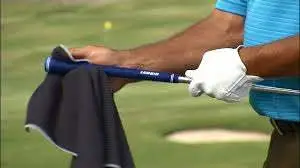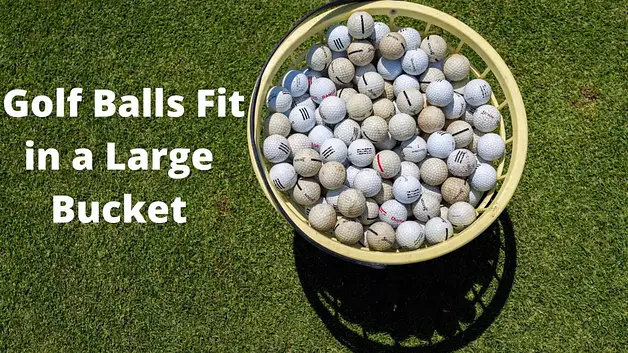Maintaining Your Grip: The Essential Guide On How to clean golf grips
Key Takeaways:
- The Importance of Clean Golf Grips: Dirty grips can negatively impact game performance and cleaning them regularly can extend the lifespan and resale value of clubs.
- Methods for Cleaning Golf Grips: Two common methods for cleaning golf grips include using warm water and mild dish soap or grip cleaning wipes.
- Frequency of Cleaning: Factors that influence the frequency of cleaning golf grips include grip style and material, as well as hand pressure and playing conditions.
The Importance of Clean Golf Grips
Dirty grips on your golf clubs can significantly impact your game performance. Not only do they affect your grip and control, but they can also reduce the lifespan of your clubs. In this section, we will explore the importance of clean golf grips, discussing how dirty grips can negatively impact your game and explaining how maintaining clean grips can extend the lifespan and increase the resale value of your clubs.

Dirty Grips Negatively Impact Game Performance
Dirty grips can be detrimental to game performance. When they get dirty, they can become slippery and lose their tackiness, making it hard to keep a secure grip. This can lead to inaccurate shots. Plus, dirt on the grips can stop you from feeling the club and making small adjustments in your swing. So, it’s important to frequently clean your golf grips for optimal performance.

Clean grips give you traction and control over your clubs. Dirt on the surface reduces friction between your hands and the grip, resulting in a weaker grip. This can cause the club to slip during the swing, resulting in mis-hits and less distance.
Clean grips also provide more feedback, so you can make precise shots. Regular cleaning of your grips helps improve your performance by giving you a consistent and reliable hold on your clubs.
Not only that, but dirty grips can also reduce the lifespan of clubs. Dirt and oils from your hands can wear down or damage the material of the grip, making it lose its shape and texture. This not only reduces its effectiveness, but could also affect the resale value of clubs. Cleaning your grips regularly helps maintain their original condition and extend their lifetime.
Extend the Lifespan and Resale Value of Clubs
Dirty grips can have a bad effect on the performance of a golfer and can even reduce the lifespan and lower the resale value of their clubs.
It’s important to note that the style and material of the grip affects how often it needs to be cleaned. Some materials need to be cleaned more often than others to prevent damage. The playing conditions and hand pressure of the golfer also affect how often the grips need to be cleaned.
Methods for Cleaning Golf Grips
Golf grips in need of a thorough clean? Discover two effective methods for restoring your grips to their original glory. One involves using warm water and mild dish soap, while the other utilizes grip cleaning wipes. Get ready to improve your grip and enhance your game with these simple yet impactful cleaning techniques.
Method 1: Warm Water and Mild Dish Soap
Golf grips need regular cleaning to keep performance optimal and clubs lasting long. Method 1, with warm water and mild dish soap, is an effective way to get rid of dirt and grime. Here are the five simple steps:
- Fill a bucket or sink with warm water.
- Add soap.
- Submerge the grips and brush or sponge away dirt and grime.
- Rinse with clean water to remove any soap residue.
- Pat dry or air dry before using.
Follow these steps and you can keep your grips clean and tacky for improved performance. But don’t overdo it! Too much cleaning can damage the grip material or strip away its tackiness. So, only clean when necessary – not after every round.
Soap and cleaning regularly are two essential elements of a winning swing and long-lasting clubs.
Step-by-Step Guide for Method 1
Clean golf grips? Essential! To have optimal performance and extend the lifespan of your clubs, use Method 1. Warm water and mild dish soap work best to remove dirt and grime. Here’s what to do:
- Fill a bucket or sink with warm water.
- Add mild dish soap.
- Submerge the grips in the soapy water.
- Use a soft brush or dry cloth, scrubbing stubborn areas.
- Rinse with clean water to remove soap residue.
- Pat with a dry towel.
Think about grip style and material when cleaning. Different materials need different methods and frequencies – refer to manufacturer guidelines, or ask a pro-club fitter for help.
Cleaning your golf grips has many benefits. It improves performance, and maintains resale value. Dirt and oils can build up on the surface of grips, reducing grip effectiveness. Clean regularly to keep your clubs in optimal condition.
Golfers have noticed improvements in their game after cleaning regularly. Better grip control and club feel during swings result in improved accuracy and distance.
Remember to clean your golf grips – it’s essential for a better golfing experience! Follow Method 1 to get optimal results.
Method 2: Grip Cleaning Wipes
Grip cleaning wipes: a great way to keep your golf grips in top condition! These wipes are specially designed to clean and maintain grips, offering a convenient solution.
Firstly, make sure you have the wipes and a clean cloth. Then, take a wipe and carefully wipe it along the length of the grip with light grip pressure. Use a circular motion to remove dirt, sweat and grime. Do this for each of your clubs.
Grip cleaning wipes give you a fast and easy way to clean your grips without water or soap. Regularly using them can maintain tackiness and prolong the life of your grips – improving your golf performance!
However, if deeply ingrained dirt or stains are present, you may need to use warm water and mild dish soap, or specialized grip cleaners. Follow manufacturer recommendations when using the wipes to get the best results and avoid any potential damage.
Grip cleaning wipes – the perfect choice for those who want to keep their grips clean without too much effort!
Recommendations for Grip Cleaning Wipes
Grip cleaning wipes are ideal for preserving cleanliness and tackiness of golf grips. They provide golfers with a simple, efficient way to keep their gear in optimal condition.
- These wipes are designed specially for golf grips, so they’re safe to use on all types of materials like rubber, synthetic and leather.
- By wiping down the grips with these specialized wipes, golfers can get rid of any buildup that affects their hold on the club.
It’s recommended to use these wipes after each round of golf or as necessary. This helps prolong the lifespan of the grips and improve performance.
Grip cleaning wipes are a great solution for keeping golf grips clean and tacky. Follow these recommendations and your grips will remain in top shape for a comfy and consistent grip during rounds of golf. Keep your grips cleaner than a sand trap!
Frequency of Cleaning
Regularly cleaning your golf grips is crucial for maintaining optimal performance on the course. In this section, we will explore the frequency of cleaning golf grips and the various factors that influence it.
Discover how external elements, such as weather conditions and usage patterns, can significantly impact how often you should clean your golf grips. Stay tuned to ensure you’re equipped with the knowledge to keep your grips in top condition, enhancing your performance and grip longevity.
Factors Influencing Cleaning Frequency
Keeping your golf grips clean is key for excellent performance on the course. How often you should clean them depends on several factors.
- Grip Style + Material: Different types and materials may need different cleaning frequencies. E.g. a rubber grip needs more frequent cleaning than a leather one.
- Hand Pressure: How much you press the club can affect how quickly dirt and sweat accumulate on your grips. Tight gripping and perspiring heavily? Clean your grips more often.
- Playing Conditions: Playing in wet or muddy places can make grips dirtier faster.
It’s important to know these factors to decide the ideal cleaning frequency for your golf grips.
Plus, here are more tips to prevent wear and make them last:
- Don’t clean too much: Excessive cleaning can cause damage. Avoid harsh chemicals or abrasive cleaners.
- Dry hands + use gloves: Dry your hands before gripping the club. Wearing a glove can keep grips from sweat and oils.
- Store properly: Store clubs in a cool, dry place away from extreme temperatures and sunlight.
- Windex for thorough cleaning: Warm water, mild soap, or Windex can help remove stubborn dirt and grime.
- More attention for putter grips: Putter grips require more cleaning due to constant exposure to dirt and oils. Regularly inspect and replace if needed.
By taking these things into account and following the tips, you can keep your golf grips clean, tacky, and in good condition, helping you perform best on the green.
Grip Style and Material
To get an insight into grip style and material, let’s explore them in a table:
| Style | Material |
| Standard | Rubber |
| Pistol | Rubber/Synthetic Compound |
| Oversized | Rubber/Synthetic Compound |
According to the table, standard grips are usually rubber. It offers comfort and tackiness, helping to keep the club secure during swings. Pistol grips are made of rubber or synthetic compounds, providing comfort and control due to their shape. Oversized grips use rubber or synthetic compounds to offer extra cushioning and reduce hand stress.
Apart from style and material, the weather and individual preferences can influence the grip choice. If it’s humid, a more tacky material might be needed to hold the club with sweaty hands. It is important to consider these factors when selecting the right grip to suit playing style.
By understanding different grip styles and materials, golfers can pick the best one for their game. It’s worth experimenting to find the perfect combination of style and material for personal needs.
Hand Pressure and Playing Conditions
Golf grips that are dirty and worn can have a huge effect on a golfer’s performance. Hand pressure and playing conditions are key to figuring out how often to clean the grips. People who grip tightly in their swing or who play in humid or sweaty weather should clean their grips more often.
The material and style of the grips can also affect how dirty they get. Some materials may absorb sweat, dirt, and oils quicker – making them need more frequent cleaning. Also, golfers who use their clean golf clubs a lot or play on courses with muddy or sandy ground must clean their grips more often.
It’s important to keep your grips clean to keep them tacky and make them last longer. By getting rid of dirt, sweat, and oil on the grip surface, golfers can control their shots better and keep the same feel throughout the round. Regularly cleaning your grips boosts performance and makes the clubs last longer.
In conclusion, it is vital to understand hand pressure and playing conditions to know how often you should clean your golf grips. Grip style, material, hand pressure, and playing environment all matter and need to be considered. By maintaining your grips, you can do better on the course and your clubs will last longer.
Knowing when to replace your golf grips is just as important as knowing when to replace your underwear!
Tips for Maintaining Clean and Tacky Grips
To keep your golf grips in optimal condition, it’s crucial to maintain their cleanliness and tackiness. In this section, we’ll explore valuable tips curated by experts in the field. From avoiding over-cleaning to utilizing Windex for thorough cleaning, we’ll cover various aspects that will help you prolong the lifespan and enhance the performance of your golf grips.
Additionally, we’ll address the importance of regular hand drying, glove usage, grip storage, and how to adapt these maintenance strategies according to different grip types.
Avoid Over-cleaning Grips
Golfers, be wary when cleaning your grips! Too much cleaning could lead to negative effects on your performance. Too frequent cleaning can rob the grips of their tackiness, making it hard to hold the club securely. Also, too much cleaning can make the grips dry and brittle, decreasing comfort and control while swinging.
Be careful with harsh chemicals or abrasive cleaning tools, as they can damage the material and reduce the grip’s lifespan. Don’t clean after every round of play – inspect for dirt and grime first. Different rounds and player preferences may mean there’s no fixed schedule for grip cleaning. Trust your judgment to decide if you need a clean.
Golf Cleaning Wipes (insert link here) make cleaning easier. They’re designed for golf grips, removing dirt, sweat and other nasties, without damaging the grip. They offer an alternative to those who want cleanliness without risking damage from improper cleaning.
It’s essential to avoid over-cleaning golf grips. Find the right balance between cleanliness and grip texture for best performance and longevity.
Regular Hand Drying and Glove Usage
Golf grips stay clean and tacky when regular hand drying and glove usage are practiced. Dry hands after each shot to stop dirt, sweat, and oils from sticking to the grips. Wear gloves during play too, to provide extra protection.
Pat hands dry rather than rub vigorously, and consider moisture-control products, such as hand powders and lotions. Maintaining these habits keeps grips fresh and ready for optimal performance. Store the clubs properly to keep them in good condition.
Grip Storage and Prevention of Damage
Storing and protecting golf grips is key for their quality and longevity. Neglecting this can lead to deterioration and poorer performance. So, it’s important to understand the best way to store them.
Avoid leaving clubs in extreme temperatures or direct sunlight. This can cause the grips to degrade over time and lose their grip. Keep them in a cool, dry place, e.g. closet or garage. This will stop moisture from seeping into the grips and damaging them.
Also, keep clubs away from sharp objects and abrasive surfaces. Club head covers offer an extra layer of protection for both the grips and the club heads.
By following these guidelines, golfers can ensure their grips remain in great condition for longer. Cleanliness is also essential for optimal performance. Both storage and cleanliness go hand in hand.
Using Windex for Thorough Cleaning
Windex is a multi-purpose glass cleaner that can be used for thorough cleaning of golf grips. It helps to remove dirt, oils, and sweat residue from the grips. To use Windex, start by spraying a small amount onto a clean cloth or paper towel. Gently wipe down the entire grip. Do this until it’s clean and grip free from any residue.
The ingredients in Windex help dissolve and lift dirt and grime from the grip surface. This can be especially beneficial for players who often play in dusty or dirty conditions.
A study found that regularly maintaining golf grips, including using Windex, can prolong their lifespan. Clean grips enhance performance and ensure durability. Incorporating regular cleanings with Windex can save players money.
Considerations for Different Types of Grips
Golf grips come in various types. It’s important to understand the unique characteristics of each type when cleaning and maintaining them. This can ensure optimal grip performance and longevity.
Different grip materials, like rubber or synthetic compounds, require specific cleaning methods. Rubber grips can be washed with mild dish soap and warm water, while synthetic grips may need special wipes.
Grips that are designed to resist weather conditions, like rain or humidity, need special care. When cleaning textured surfaces, be careful not to damage the texture with harsh chemicals or abrasive tools.
Grip size is also important. Certain materials may shrink or expand when exposed to water or cleaning agents – this affects their fit.
Understand the requirements of each grip type. This can help you decide when to replace and how to maintain them.
Manufacturers have made innovative grips with improved performance and durability. Consider all the characteristics of your chosen grip to make informed decisions about cleaning and maintenance – this will help you get better performance on the course.
Putter Grips and Their Replacement Frequency
Grips for putters, like all other golf grips, need to be switched out regularly for top performance on the green. Neglecting to replace putter grips when they should can affect a golfer’s game negatively and wear on the clubs.
- When to Replace Putter Grips: The rate at which you should replace putter grips depends on several elements. This includes the material of the grip, the usage it gets, and the golfer’s personal preference. Grips made from softer material may get worn out quicker and need replacement more often. Players who play often or in wet or humid conditions may need to change their putter grip more often.
- Signs Indicating Need for Replacement: It’s important for golfers to look at their putter grip often for signs that show it’s time to replace it. Common signs are cracks or splits in the grip material, loss of tackiness or texture, and thinning or flattening of the grip. If any of these signs are visible, it’s time for a replacement.
- Replacement Options: When it’s time to switch out a putter grip, golfers have two choices: DIY replacement or getting assistance from a local club professional or golf shop. DIY needs specific tools and skills but can be cost effective for tech-savvy people. Getting help from a professional makes sure the grip is installed properly and works as it should.
In addition to inspecting and replacing regularly, here are some tips to help golfers keep their putter grips clean and sticky. Avoid over-cleaning, dry your hands before gripping the club, store clubs properly, and use products like Windex for thorough cleaning whenever needed.
Putter grips may need to be changed more often compared to other golf club grips because of the specific demands on the putting green. Knowing the factors that influence replacement frequency and following proper maintenance will ensure putter grips are in great shape for each round of golf.
Conclusion: Simple and Important Task of Cleaning Golf Grips
Cleaning golf grips is important. It helps keep their look and allows for top performance on the golf course. Dirty, slippery grips can lead to bad swings and shots.
- Get a soft-bristle brush or towel to remove surface dirt.
- Get a basin or sink and fill it with warm water and little mild dish soap.
- Move the water around to make a soapy mix.
- Put the grips in the soapy water and use hands or a sponge to scrub.
- Focus on spots where dirt is stuck.
- Rinse the grips with clean water to take away soap residue.
- Dry the grips with a towel, then let them air dry. This stops moisture getting trapped between the grips and the shaft, which can cause damage or mold.
- Clean your grips after several rounds of golf or as needed.
Doing this regularly keeps the grips looking good and lasting longer. Also, you get a consistent and secure grip, allowing you to control your shots better. Cleaning your golf grips is quick and beneficial.
Some Facts About How to Clean Golf Grips:
- ✅ Proper cleaning of golf grips can restore their tackiness and improve traction. (Source: Team Research)
- ✅ Rubber grips absorb sweat, dirt, and other substances over time, which can harden them and reduce traction. (Source: Team Research)
- ✅ Cleaning golf grips can be done using a combination of hot water, dish soap, and a scrub brush. (Source: Team Research)
- ✅ Wiping grips with Windex after cleaning can restore their tacky feeling. (Source: Team Research)
- ✅ Regularly cleaning grips is a cost-effective way to maintain their condition and avoid the need for replacement. (Source: Various)
FAQs about How To Clean Golf Grips
How can I clean my golf grips without spending any money?
You can clean your golf grips without any investment by using a combination of hot water, dish soap, and a scrub brush. This can remove dirt, sweat, and other substances that can harden the grips over time and reduce traction. After cleaning, you can restore the tacky feeling to rubber grips by using Windex.
What should I do if I don’t have time for a full grip cleaning?
If you don’t have time for a full cleaning, you can still improve traction and remove surface dirt by spraying Windex on your grips and using a damp cloth to wipe them down. This quick method can help maintain the condition of your grips until you have more time for a thorough cleaning.
How often should I clean my golf club grips?
Regular cleaning of golf club grips is important to prevent them from wearing down and losing their tackiness. Casual golfers should clean their grips once or twice a year, while avid golfers should clean them at least once a month. Factors like grip style, hand pressure, frequency of play, and playing conditions can also affect how often you should clean your grips.
Can I clean leather golf grips?
Yes, you can clean leather golf grips by wiping them down with a wet towel once a week. It is recommended to avoid using detergents or soaps on leather grips. This regular maintenance can help keep leather grips in good working condition.
When should I consider replacing my golf grips?
If cleaning your golf grips doesn’t restore their tackiness and they continue to feel hard and slippery, it may be time to replace them with new grips. Golf grips should generally be replaced every year or after around 30 to 50 rounds of play to ensure optimal performance and a secure hold on the club.
Are there any specialty products available for cleaning golf grips?
Yes, there are specialty products available specifically made for cleaning golf grips. One recommended product is the Lamkin GRIPES Grip Cleaning Wipes. These wipes are user-friendly, inexpensive, and quickly restore grip tackiness. They come in a pack of 15 pre-moistened wipes.





